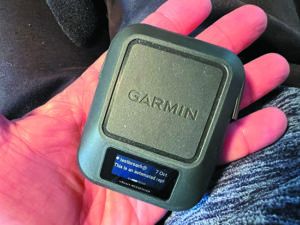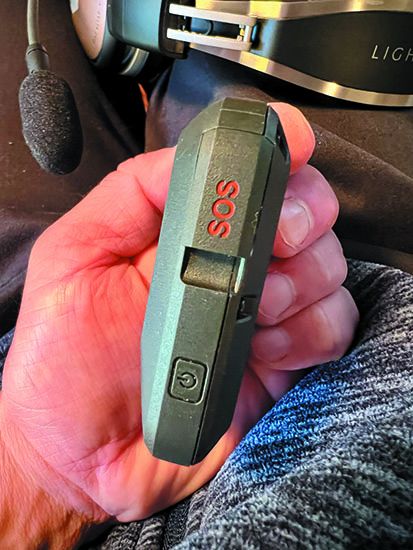Just when we thought the market had enough personal satellite trackers, Garmin tosses the inReach Messenger in the ring. Think simple, small and fairly priced—all good things for those needing another layer of backstop when flying outside of cellular coverage.
Like the other inReach models in Garmin’s lineup, the $299 Messenger uses the subscription-based Iridium satcom network, and it’s optimized to also use a cellular connection from the paired smartphone. The device offers global two-way messenging capability, plus an interactive SOS function that pings Garmin’s IERCC (International Emergency Response Coordination Center) that’s staffed 24/7.
SMALL SIZE, GOOD BATTERY

The 4-ounce Messenger is self-contained in a 3.1 by 2.5 inch impact-resistant chassis that’s water-rated to IPX7 standards, which means it can be exposed to 1 meter of water for 30 minutes. Battery life is good, and the internal rechargeable lithium keeps the device running for up to 28 days when set for a 10-minute refresh tracking interval. It’s smart enough to conserve power when you need it the most. Initiate an SOS and for the first 10 minutes an updated location is sent every minute, and reduced to every 10 minutes thereafter. There’s a USB-C port on the side of the case for recharging/computer interfacing. If your smartphone battery goes flat, there’s a “safety charging” feature from a connected Messenger that provides just enough reverse charging juice to send a custom text message from the phone.
The control set is minimal and there’s no touchscreen or keypad. Rocker keys scroll left and right through the shallow display menu, and there’s an Enter (OK) key. Texting is done through the Garmin Messenger smartphone app (which syncs with your contacts list), while the small on-device display is used for status icons, to confirm that messages have been sent, activating the service plan and for using the TracBack feature. This is for navigating back to the beginning of your recorded path/points if you get lost. You can also view messages onscreen.
Speaking of messages, when you send them, the device listens for replies for 10 minutes, and it checks for new messages every hour. When you are using the tracking feature, it checks for messages at your set tracking interval. We found that the Messenger app is the best way to communicate, and it has a familiar texting feature set that mimics the messaging feature set on smartphones.
There’s also the inReach Weather utility on some subscription plans. Basically, the device can send an inReach message to request basic, extended or marine weather forecasts. You can receive weather forecasts for your current location or a new location, such as a saved waypoint. Weather forecasts incur data charges or additional charges on your inReach subscription. Frankly we don’t see the value for aviation ops given other obvious sources.
SENDING OUT AN SOS
The SOS key is on the right side of the case and protected by a cap. We like that an SOS can be sent when the unit is turned off (as long as it has battery life, of course). Hold the button and wait for the SOS countdown. The device sends a default message (and you can set custom ones) to the emergency response service with details about your location, plus you can also initiate an SOS (and interact with Garmin IERCC) through the Messenger app. Canceling an SOS is done by pressing and holding the button and waiting for the cancellation prompt.
Subscription plans start at $14.95 per month and there are a variety of options depending on usage. We covered mini satcoms including Garmin’s inReach Mini 2 in the April 2022 Aviation Consumer.


